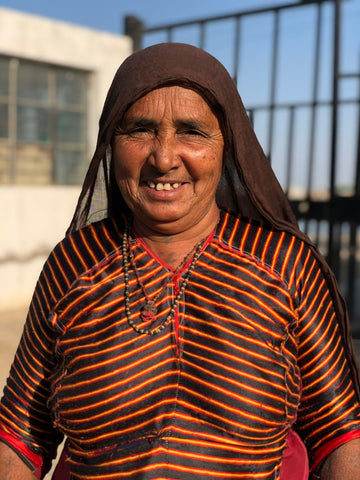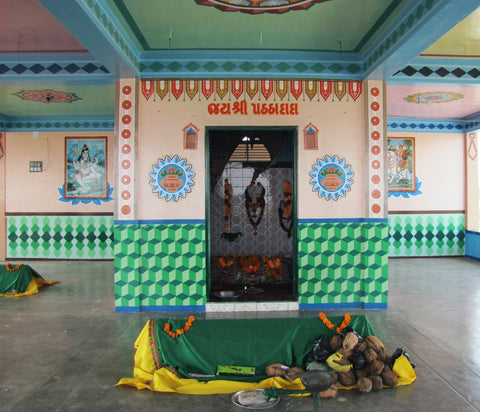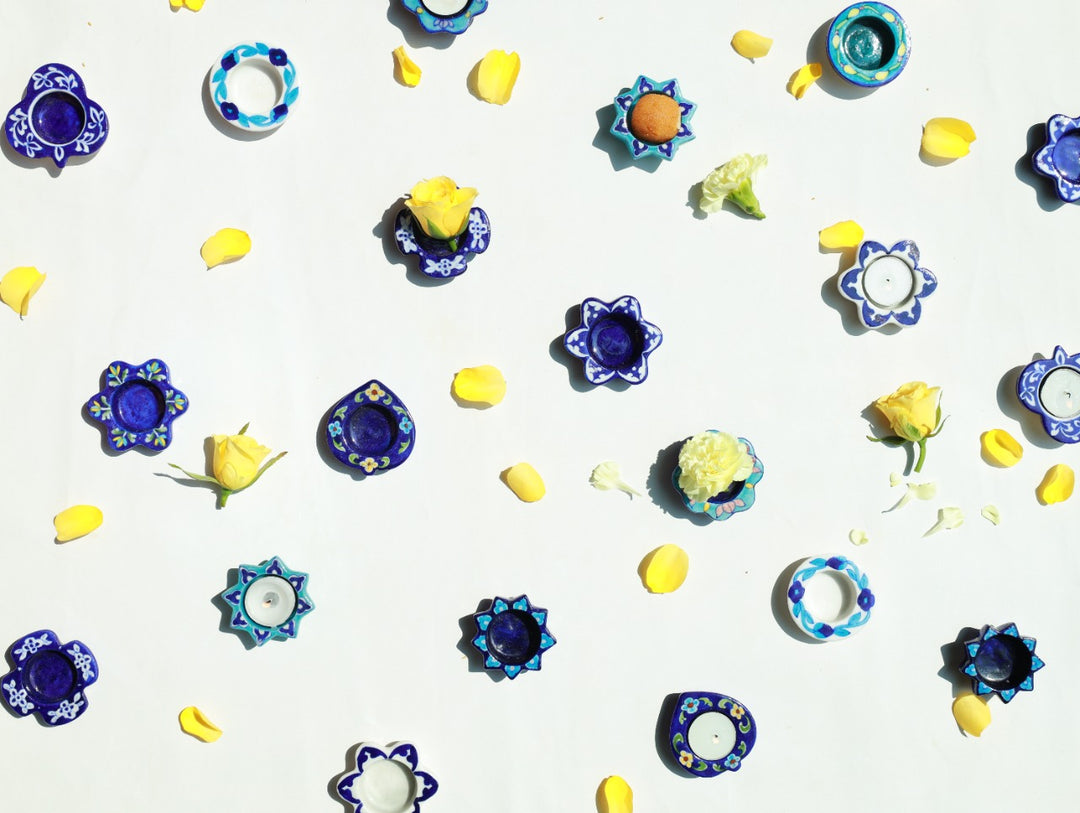Rabari: Nomads of the Great White Desert
by Nisha Sastry
5th October 2020

Rabari embroiderer finishing our cushions
The Rabaris are one of the indigenous tribal communities of north-west India, spread across Gujarat, Rajasthan and Punjab. They are nomadic, pastoral community, traditional camel herders but adapting to modern times, they maintain flocks of sheep and goats as well now. The Rabaris are a close-knit community with customs, traditions, and mythology unique to them. It is widely believed that they migrated to India from Iran via Afghanistan around a thousand years ago1 and annual migration, chasing the monsoons, in search of green pastures for their herds is still part of their lifestyle.

Rabari woman dressed in traditionally dark clothes
The Rabari mythology2,3 traces their origins back to the Himalayas, to Shiva and Parvathi, residing in Mount Kailash. It is believed that the first Rabari man, Sambad, was created by the celestial duo to tend to their five-legged camel. When Sambad complained about difficulty in grazing this peculiar five legged being, Shiva pushed the central leg of the camel upwards, creating the hump and asked Sambad to live free, looking after the camel. That’s why, for the nomadic Rabari, who consider themselves progeny of Sambad and Rai, an apsara, camel herding is the primary occupation. Another mythological tale suggests that the Rabari had settled in Mathura. When Lord Krishna decided to migrate to Dwaraka, the Rabari followed suit, along with the Lord’s Yadava clan and settled in different parts of Gujarat, but mainly in present day Kutch.2,3
According to one of their traditional oral narration, the Rabari’s believe they had actually settled in Jaisalmer, Rajasthan, once ruled by a Muslim ruler, who fell in love with a Rabari girl. When the Rabari denied the King’s insistence on marrying the girl, the King imprisoned the prominent leaders of the Rabari community, asking for the girl in exchange for the freedom of their leaders. The Rabari’s maintain, they fled Jaisalmer, in the dead of the night, to save the modesty and honour of their daughter and sought patronage by the benevolent ruler of Kutch3. As penitence to mark this shameful escape, the community as a whole decided to wear only black and white clothes.1,3

Dargah of Pathaji Pir, Sahapedia. 2018
Although the Rabari are fiercely Hindu, they have unique tradition of worshipping Sufi Pirs. Like many of their traditional tales, the Rabaris believe their ancestral village Mindiyala, when faced with water scarcity, the leader who lead them there, Harpal, decided to undertake a penance before the Dargah of Pathaji Pir in Sindh. The Sufi saint, impressed by Harpal’s penance, appeared in his dream and asked him to look out for signs when he dug the well, the first sign, water will arise from north, second, a fish would appear in the water with a Sindhi rice grain in its mouth and the final sign, a plant called Mindi would grow in the well and asked Harpal to name the village Mindiyala in his honour1,3. Back in the village, Harpal followed the instructions and found water. To commemorate this feat and to offer their gratefulness to their hero, the villagers have constructed a Dargah, in honour of Pathaji Pir, where they believe will be no discrimination on any grounds. The community believes that because of the grace of the Sufi saint, the water from the well will never dry up and no living being will die if it falls in the well.
 Nisha is a senior research fellow, working towards her PhD, specialising in computational neuroscience at National Brain Research Centre, Manesar. She dabbles in music and history to sprinkle novelty and to maintain her sanity during PhD.
Nisha is a senior research fellow, working towards her PhD, specialising in computational neuroscience at National Brain Research Centre, Manesar. She dabbles in music and history to sprinkle novelty and to maintain her sanity during PhD.
References:
- Rabari Tribe of Gujarat (Vol. I – Vol.VIII), Indira Gandhi Rashtriya Manav Sangrahalaya, Bhopal (IGRMS), Internet archive, 1999.
- Patel, H.R, Hanoz 2018. The Rabaris: Nomadic Pastoral Community of Kutch. Sahapedia
- Hanoz Patel in conversation with Rabari Jesang Bhai Hadu Bhai Bhaar, Modsar Village, Kutch-Bhuj. Video. Sahapedia
Images: Image of Dargah Pathaji Pir by Sahapedia. 2018
Note: The Image of Dargah Pathaji Pir is shared under CC-BY-NC-SA 4.0 Licence
https://creativecommons.org/licenses/by-nc-sa/4.0/












Leave a comment